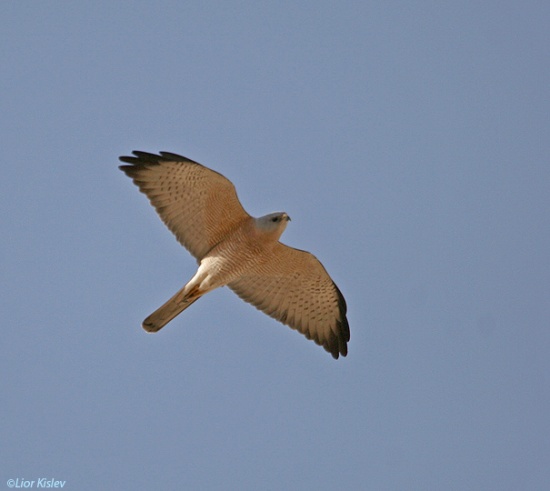|
|
| Line 1: |
Line 1: |
| | + | [[category:incomplete]] |
| | ;Accipiter brevipes | | ;Accipiter brevipes |
| − | [[Image:Levant_Sparrowhawk.jpg|thumb|550px|right|Photo by <b>lior kislev in Eylat, Israel]] | + | [[Image:Levant_Sparrowhawk.jpg|thumb|550px|right|Photo by lior kislev in Eylat, Israel]] |
| | ==Identification== | | ==Identification== |
| − | Levant Sparrowhawk
| + | 30-37 cm. Female is larger than the male. Blue-grey above, with dark wingtips, and barred reddish below. The adult female is slate-grey above with darkish wingtips, barred reddish brown below, dark throat line. The juvenile is dark brown above and has dark-streaked underparts. It shows a dark throat line. |
| − | Accipiter brevipes
| |
| − | | |
| − | | |
| − | The Levant Sparrowhawk (Accipiter brevipes) is a small bird of prey in the family Accipitridae which also includes many other diurnal raptors such as eagles, buzzards and harriers.
| |
| − | This bird is a small raptor with short broad wings and a longish tail, both adaptations to manoeuvring through trees. It is similar to the Eurasian Sparrowhawk, but its shorter tail and more pointed wings give it a more falcon-like appearance.
| |
| − | | |
| − | Levant Sparrowhawk is 30-37 cm long with a 63-76 cm wingspan. The female is larger than the male, but the difference is not as marked as with Eurasian Sparrowhawk. The adult male is blue-grey above, with dark wingtips, and barred reddish below.
| |
| − | | |
| − | The adult female is slate-grey above with darkish wingtips. She is barred reddish brown below, and may show a dark throat line. The juvenile is dark brown above and has dark-streaked underparts. It shows a dark throat line. The flight of this hawk is a characteristic "flap – flap – glide". | |
| | | | |
| | ==Distribution== | | ==Distribution== |
| − | It breeds in forests from Greece and the Balkans east to southern Russia. It is migratory, wintering from Egypt across to southwestern Iran. It will migrate in large flocks, unlike the more widespread Eurasian Sparrowhawk.
| + | [[Greece]], the [[Balkans]] and southern [[Russia]]. |
| − | A summer visitor to the southern Ukraine and east across southern Russia
| |
| − | to Kazakstan and in scattered parts of South-East Europe. There are small, isolated populations in southern Romania and Bulgaria, the former Yugoslavia, probably Albania and in particular, Greece, and has bred in small numbers in south-east Hungary. In addition, breeds in western and northern Turkey and the Caucasus.
| |
| − | Winters in East Africa and seen on passage across Turkey, the Middle East and Egypt. The Bosphorus is the preferred migration route with smaller numbers through the Caucasus and the passage period is mid August-early October, peaking in the second half of September. The return movement takes place in mid-late April. Passage is very concentrated and most of the population move through in a few days in dense flocks.
| |
| − | Vagrants recorded in Poland, Cyprus, Italy and Tunisia and a rare passage migrant to Kuwait.
| |
| | ==Taxonomy== | | ==Taxonomy== |
| | | | |
| | ==Habitat== | | ==Habitat== |
| − | Deciduous woodland, in dry, hilly or lowland areas, often along rivers. Sometimes breeds in stands of trees in open cultivated land. | + | Deciduous woodland, in dry, hilly or lowland areas, often along rivers. |
| | | | |
| | ==Behaviour== | | ==Behaviour== |
| − | The Levant Sparrowhawk nests in trees, building a new nest, lined with green leaves, each year. The normal clutch is 3-5 eggs. It hunts small birds, insects and lizards in woodland, relying on surprise as it flies from a perch to catch its prey unaware.
| + | It nests in trees, building a new nest, lined with green leaves, each year. 3-5 eggs are laid. |
| | + | |
| | + | Diet includes small birds, insects and lizards in woodland, relying on surprise as it flies from a perch to catch its prey unaware. |
| | | | |
| | The call is a sharp "kee-wick". | | The call is a sharp "kee-wick". |
- Accipiter brevipes

Photo by lior kislev in Eylat, Israel
Identification
30-37 cm. Female is larger than the male. Blue-grey above, with dark wingtips, and barred reddish below. The adult female is slate-grey above with darkish wingtips, barred reddish brown below, dark throat line. The juvenile is dark brown above and has dark-streaked underparts. It shows a dark throat line.
Distribution
Greece, the Balkans and southern Russia.
Taxonomy
Habitat
Deciduous woodland, in dry, hilly or lowland areas, often along rivers.
Behaviour
It nests in trees, building a new nest, lined with green leaves, each year. 3-5 eggs are laid.
Diet includes small birds, insects and lizards in woodland, relying on surprise as it flies from a perch to catch its prey unaware.
The call is a sharp "kee-wick".
External Links




